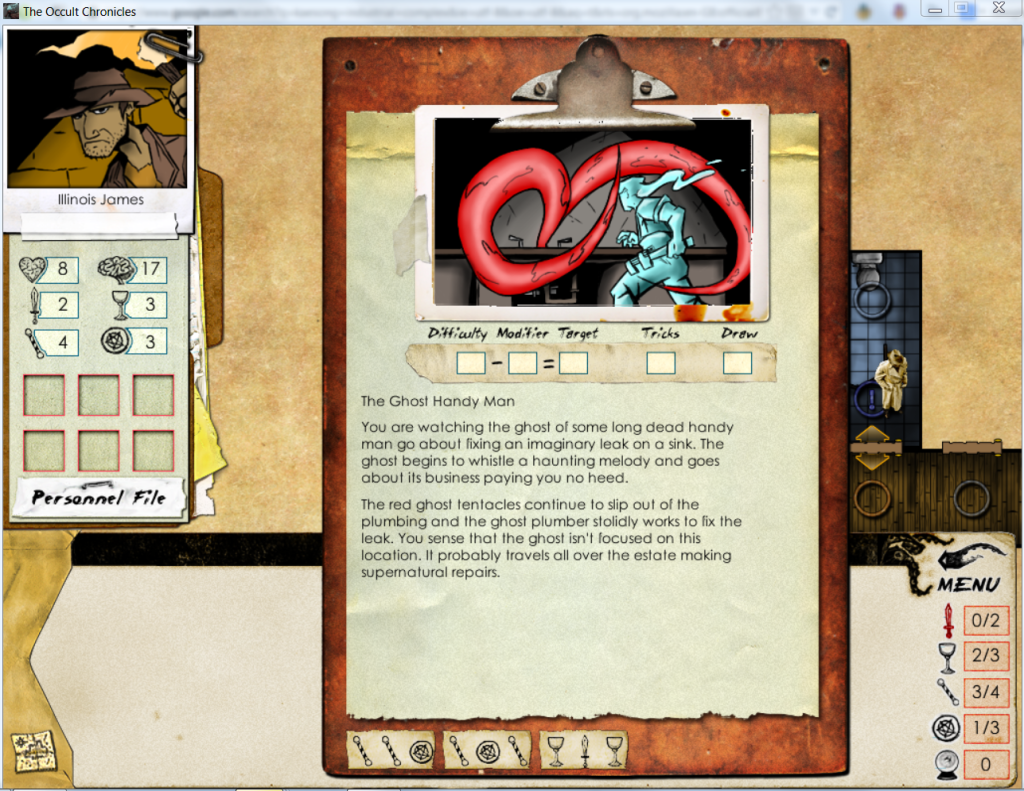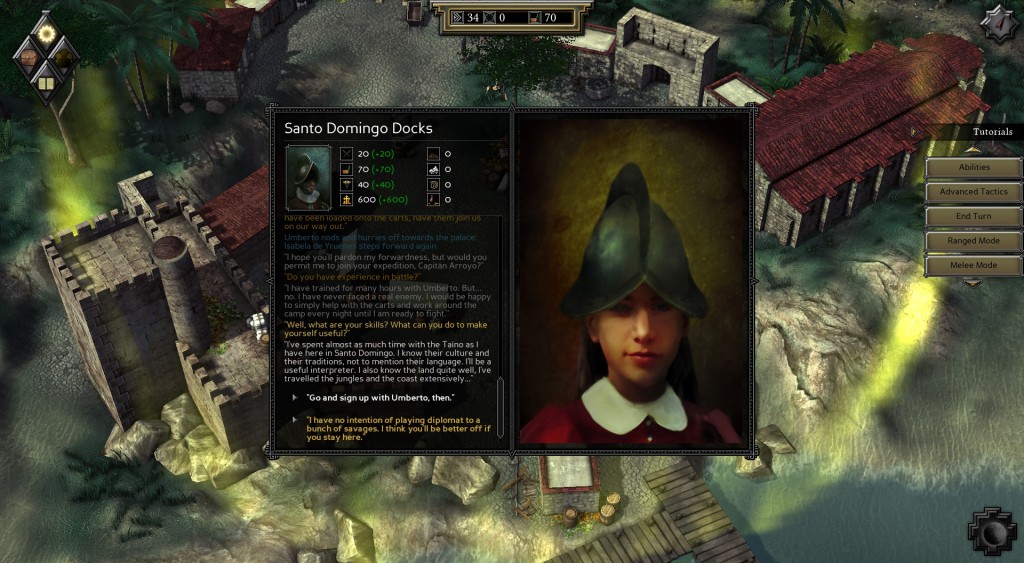I’m long overdue to post my impressions of two recent, interesting games, Occult Chronicles (still officially in “buy-in beta”) and Expeditions Conquistador. While they are very different, they have enough in common to be worth discussing in the same post, so let’s take a look:
Occult Chronicles is the latest project from Vic Davis (of Armageddon Empires fame); it is inspired by roguelikes and “haunted house” board games. The player controls a single investigator who wanders around a haunted mansion, uncovering tiles with each step. Most tiles are blank, but some contain encounters, which are represented as a series of randomly selected cards (e.g. a three of Wands, a Knight of Cups) that the player’s own random cards must beat. The player character gradually levels up or acquires new goodies from beating these encounters; and ultimately, s/he must descend into the basement of the house for the final encounter. Strategy is a matter of resource allocation and balancing risk/reward: Do I use my finite pool of items to modify this card draw, or do I save them for a rainy day? How do I allot my skill points? How much time can I afford to spend levelling upstairs before the – luckily customisable – in-game timer (1) pressures me to head into the basement? My biggest reservation is that there is still a lot of chance involved, especially visible (a) on higher difficulty levels (I’ve never won on anything above the easiest setting!), (b) early on, as low-level characters have few ways to influence the cards, and (c) in the occasional bouts of random sadism (2).
Conquistador is a bit like a cross between a tactical RPG and an Age of Discovery-themed King’s Bounty. The player character rides around the overworld map in search of quests, resolves them via dialogue or violence, and fights out battles on a hex grid using a squad of up to six. Character customisation is fairly limited, but combat is distinct and satisfying. The basic strategy (use tanky characters to slow down the enemy, while healers, ranged specialists, and fast-moving characters play to their respective strengths) comes from Tactical RPGs 101, and can safely be recycled in every battle, but the details change: I might use a barricade (3) to block off a given route on the battle map, then park an arquebusier there to snipe from safety; or use Character A to stun an enemy so the injured Character B can safely slip past. In between battles, the player must manage the camp to ensure food and medicine don’t run out, though in practice this is simple with the right party.
What these games have in common is, first, interesting encounters. OC’s setting is pure B-movie material, but the writing is wryly self-aware and the art pleasingly whimsical. How many games let you help a ghostly baker exorcise his possessed oven? Meanwhile, though Conquistador’s encounters tend to be shallow in their moral choices (think old-school Bioware – do you politely greet the natives or do you massacre them?!), they are atmospheric and gorgeously illustrated. Here are examples:


At least on normal difficulty, Conquistador also has a certain sense of flow, of being caught up in the rhythm between one encounter and the next – think a less addictive version of “just one more turn”. The music is a big help, and I suspect that the routine of making camp at the end of each game day, while fiddly, might also be a way to settle the player in. On easy difficulty, OC offers a similar experience – it’s satisfying to lean back, discover new rooms and encounters, and watch my stats slowly tick up. (However, I do not think OC offers this experience on normal difficulty. Normal is a lot harder and feels much more like a roller coaster – think FTL.)
Now, I should note I’m not an expert on either game – I’m 17 hours and maybe 2/3rds through Conquistador, and while I’m several hours (and one successful game on easy) into OC, I’m still learning how to build an effective character. But at this stage, I quite like them both; and both illustrate the way games with modest budgets but original twists have made their comeback in the last few years. If my descriptions caught your fancy, I think they’re definitely worth a look.
(1) The timer counts the number of turns taken by the player, rather than real-life time. I find it less stressful, and more fun, to turn it off entirely.
(2) For example, the basement is the most dangerous part of the house; the ground floor, where the player starts, is the safest. But certain encounters – such as precarious walkways – can drop you from the ground floor down into the basement, which is a death sentence for a low-level character. Ouch!
(3) Crafted on the world map.
ETA because I’m forgetful – the comments above are based on a copy of Occult Chronicles supplied by the developer.
Discover more from Matchsticks for my Eyes
Subscribe to get the latest posts sent to your email.